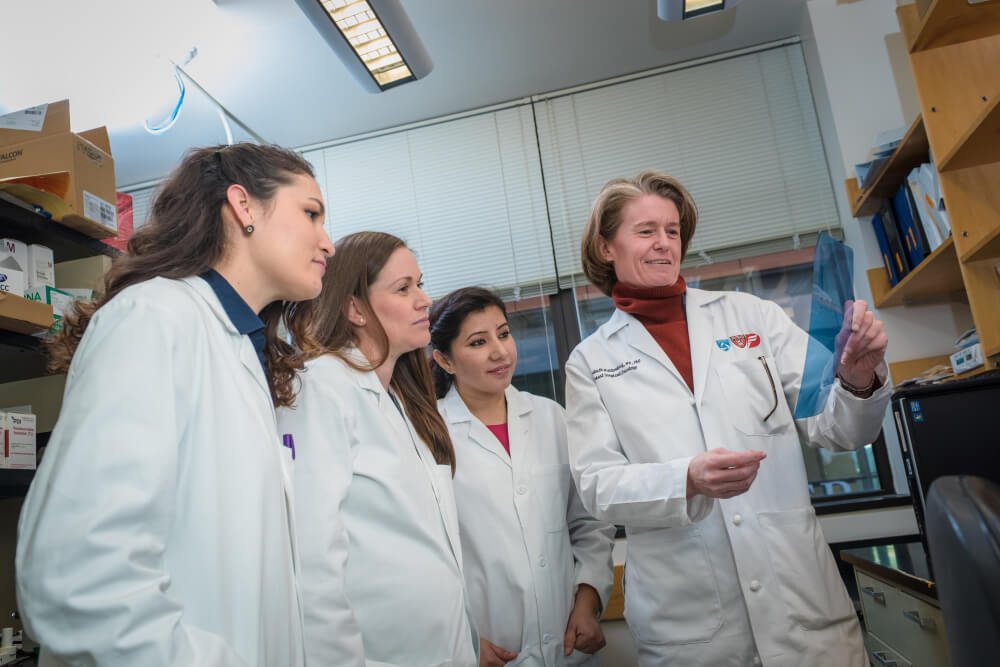When someone is diagnosed with breast cancer, doctors determine the stage of the disease – which indicates how much cancer is in the body, whether it has spread beyond the breast, and, if so, how extensively. The stage of a cancer is often related to a patient’s prognosis and guides the treatment they receive.

Breast cancers are staged on a scale from zero to four. The lower the number, the less the cancer has spread.
- Stage 0 breast cancer is a non-invasive condition sometimes described as pre-cancerous. Stage 0 breast cancers include ductal carcinoma in situ (DCIS) and lobular carcinoma in situ (LCIS). These diseases are not considered life-threatening, but can become invasive over time if not appropriately treated. Both increase the risk of developing breast cancer in the future.
- Stage I cancer usually involves a tumor that is two centimeters or smaller and has not spread outside the breast. Stage I cancers are almost always curable.
- Stage II and III cancer includes medium- to larger-sized tumors as well as tumors with positive lymph nodes. With advances in breast care treatment, stage II and stage III cancers are often curable, but many require additional treatments to achieve this goal.
- In Stage IV, the cancer has spread to other organs of the body, most often the bones, lungs, or liver. Another name for Stage IV cancer is metastatic cancer.
Traditionally, staging has been based on three factors: the size of the tumor; the number and location of lymph nodes with tumor cells; and whether or not the cancer has spread to other parts of the body. This is known as the TNM system, in which T stands for Tumor size, N stands for Lymph Node status, and M stands for Metastases.
This year, the American Joint Committee on Cancer (AJCC) implemented a new system in which stage designations also take into account biological information about the tumor cells, including tumor grade (how abnormal the cancer cells look under a microscope), presence of cell receptors for estrogen and progesterone (hormones that can drive cancer cell growth), and abnormally high levels of the protein HER2.
For certain patients, such as those with hormone receptor-positive breast cancer that has not yet spread to the lymph nodes, the new system also takes into account patterns of gene activity that indicate how aggressive a tumor might be or how well it might respond to certain therapies.
These measures can play an important role in a patient’s prognosis, and therefore are useful in staging. For example, a patient with a large breast tumor might have a better prognosis than a patient with a small tumor if the large tumor consists of relatively normal-looking, slow-growing cancer cells that respond to hormone-blocking therapies, and the smaller tumor is made up of fast-growing cancer cells that don’t respond to such therapies. These biological differences would now be reflected in the stage assigned to each of these tumors.
“This new staging system is an important advance because it reflects the way we treat breast cancer patients: specifically, that therapeutic recommendations are based not only on the anatomic extent of the disease but also the underlying biology of the tumor,” says Elizabeth A. Mittendorf, MD, PhD, a director of Surgical Research in the Breast Oncology Program at the Susan F. Smith Center for Women’s Cancers at Dana-Farber and director of the Breast Immuno-Oncology Program at Dana-Farber/Brigham and Women’s Cancer Center. Mittendorf served on the panel that revised the AJCC staging system.
Learn more about treatment for breast cancer from Dana-Farber Cancer Institute.
